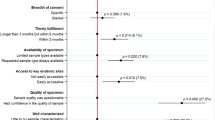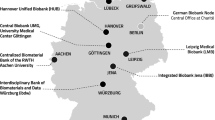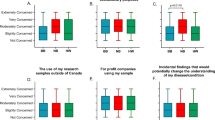Abstract
Various forms of private investment are considered necessary for the sustainability of biobanks, yet pose significant challenges to public trust. To manage this tension, it is vital to identify the concerns of relevant stakeholders to ensure effective and acceptable policy and practice. This research examines the aspects of commercialisation that are of most concern to the Australian public (n = 800) and patients who had donated their tissue to two large disease specific (cancer) public biobanks (n = 564). Overall, we found a commercialisation effect (higher support for public relative to private) in relation to funding, research location and access to stored biospecimens. The effect was strongest for research locations and access compared to funding. A latent class analysis revealed the pattern of concern differed, with the majority (34.1%) opposing all aspects of commercialisation, a minority supporting all (15.7%), one quarter (26.8%) opposing some (sharing and selling tissue) but not others (research locations and funding), and a group who were unsure about most aspects but opposed selling tissue (23.5%). Patient donors were found to be more accepting of and unsure about most aspects of commercialisation. Members of the (general) public who were motivated to participate in biobanking were more likely to oppose some aspects while supporting others, while those who indicated they would not donate to a biobank were more likely to oppose all aspects of commercialisation. The results suggest that approaches to policy, engagement and awareness raising need to be tailored for different publics and patient groups to increase participation.
This is a preview of subscription content, access via your institution
Access options
Subscribe to this journal
Receive 12 print issues and online access
$259.00 per year
only $21.58 per issue
Buy this article
- Purchase on SpringerLink
- Instant access to full article PDF
Prices may be subject to local taxes which are calculated during checkout

Similar content being viewed by others
References
Caulfield T, Burningham S, Joly Y, Master Z, Shabani M, Borry P, et al. A review of the key issues associated with the commercialization of biobanks. J Law Biosci. 2014;1:94–110.
Catchpoole DR. Getting the message about biobanking: returning to the basics. J Biorepository Sci Appl Med. 2017;5:9.
Chalmers D, Nicol D, Kaye J, Bell J, Campbell AV, Ho CW, et al. Has the biobank bubble burst? Withstanding the challenges for sustainable biobanking in the digital era. BMC Med Ethics. 2016;17:39.
Hämäläinen I, Toernwall O, Simell B, Zatloukal K, Perola M, van Ommen GJB. Role of Academic Biobanks in Public–Private Partnerships in the European Biobanking and BioMolecular Resources Research Infrastructure Community. Biopreservation Biobanking. 2019;17:46–51.
Biobanks need pharma. Nature. 2009;461:448. https://doi.org/10.1038/461448a.
van Ommen GJB, Törnwall O, Bréchot C, Dagher G, Galli J, Hveem K, et al. BBMRI-ERIC as a resource for pharmaceutical and life science industries: the development of biobank-based Expert Centres. Eur J Hum Genet. 2015;23:893–900.
Watson PH, Nussbeck SY, Carter C, O’Donoghue S, Cheah S, Matzke LA, et al. A framework for biobank sustainability. Biopreservation Biobanking. 2014;12:60–8.
Kaufman DJ, Murphy-Bollinger J, Scott J, Hudson KL. Public opinion about the importance of privacy in biobank research. Am J Hum Genet. 2009;85:643–54.
Kaye J, Whitley EA, Lund D, Morrison M, Teare H, Melham K. 2015. Dynamic consent: a patient interface for twenty-first century research networks. Eur J Hum Genet. 2015;23:141.
Critchley C, Nicol D, McWhirter R. Identifying public expectations of genetic biobanks. Public Underst Sci. 2017;26:671–87.
Caulfield T, Ogbogu U. The commercialization of university-based research: balancing risks and benefits. BMC Med Ethics. 2015;16:70.
Critchley CR, Bruce G, Farrugia M. The impact of commercialisation on public perceptions of stem cell research: Exploring differences across the use of induced pluripotent cells, human and animal embryos. Stem Cell Rev Rep. 2013;9:541–54.
Critchley C, Nicol D, Otlowski M. The impact of commercialisation and genetic data sharing arrangements on public trust and the intention to participate in biobank research. Public Health Genom. 2015;18:160–72.
Nicol D, Critchley C, McWhirter R, Whitton T. Understanding public reactions to commercialization of biobanks and use of biobank resources. Soc Sci Med. 2016;162:79–87.
Einsiedel EF. Public perceptions of transgenic animals. Rev Scientifique et Tech-Off Int Des Epizooties. 2005;24:149.
Caulfield T, Rachul C. Nelson E: biobanking, consent, and control: a survey of albertans on key research ethics issues. Biopreser Biobank. 2012;10:433–8.
Master Z, Claudio JO, Rachul C, Wang JCY, Minden MD, Caufield T. Cancer Patient Perceptions on the Ethical and Legal Issues Related to Biobanking. BMC Med Genom. 2013;6:8.
Spector-Bagdady K, De Vries RG, Gornick MG, Shuman AG, Kardia S, Platt J. Encouraging participation and transparency in biobank research. Health Aff. 2018;37:1313–20.
Fleming J. Issues with tissues: perspective of tissue bank donors and the public towards biobanks and related genetic research. In Stranger ME, editors. Human biotechnology and public trust: trends, perceptions and regulation. Hobart: Centre for Law and Genetics, Uni Tas; 2007. p. 184–201.
Steinsbekk KS, Ursin LØ, Skolbekken JA, Solberg B. We’re not in it for the money—lay people’s moral intuitions on commercial use of ‘their’ biobank. Med Health Care Philos. 2013;16:151–62.
Haddow G, Laurie G, Cunningham-Burley S, Hunter KG. Tackling community concerns about commercialisation and genetic research: a modest interdisciplinary proposal. Soc Sci Med. 2007;64:272–82.
Husedzinovic A, Ose D, Schickhardt C, Fröhling S, Winkler EC. Stakeholders’ perspectives on biobank-based genomic research: systematic review of the literature. Eur J Hum Genet. 2015;23:1607–14.
Lee SSJ, Cho MK, Kraft SA, Varsava N, Gillespie K, Ormond KE, et al. “I don’t want to be Henrietta Lacks”: diverse patient perspectives on donating biospecimens for precision medicine research. Genet Med. 2019;21:107–13.
Chalmers D, Nicol D, Nicolas P, Zeps N. A Role for Research Ethics Committees in Exchanges of Biospecimens through Material Transfer Agreements. J Bioethical Inq. 2014;11:301–6.
Acknowledgements
We would like to acknowledge the National Health and Medical Research Council of Australia for funding this research NHMRC Project Grant: APP102929 (CIA Kerridge). We sincerely thank all biobank donors and members of the public for taking the time to share their views with us. Special thanks are also due to members of the CATI team at Swinburne University for conducting the telephone interviews for the national survey, and to Jarrod Walshe for technical assistance. All authors report no conflict of interest with this research. The data that support the findings of this study are available from the corresponding author upon reasonable request.
Author information
Authors and Affiliations
Corresponding author
Ethics declarations
Conflict of interest
The authors declare that they have no conflict of interest.
Additional information
Publisher’s note Springer Nature remains neutral with regard to jurisdictional claims in published maps and institutional affiliations.
Supplementary information
Rights and permissions
About this article
Cite this article
Critchley, C.R., Fleming, J., Nicol, D. et al. Identifying the nature and extent of public and donor concern about the commercialisation of biobanks for genomic research. Eur J Hum Genet 29, 503–511 (2021). https://doi.org/10.1038/s41431-020-00746-0
Received:
Revised:
Accepted:
Published:
Issue date:
DOI: https://doi.org/10.1038/s41431-020-00746-0
This article is cited by
-
Opportunities for a national genomic data governance framework in Australia: a systematic review
BMC Medical Ethics (2025)
-
Incorporating biobanking into the future of healthcare: exploring patient and healthcare worker perspectives at a Canadian tertiary academic hospital
European Journal of Human Genetics (2025)
-
Research opportunities in precision oncology: perspectives on biospecimen and genomic data sharing from adults with cancer in Ireland
Irish Journal of Medical Science (1971 -) (2025)
-
A message to biobanks: get the word out or be out
Discover Health Systems (2025)
-
Understanding the value of biobank attributes to researchers using a conjoint experiment
Scientific Reports (2023)



